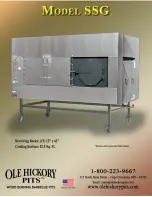
9
5. FINAL OPERATIONS
After replacing the nozzles, reposition the flame-spreader crowns, the burner caps and the pan
stands. Following the adjustment to a new type of gas, replace the gas adjustment label fixed to
the appliance with the one corresponding to the new gas. The label is inserted in the pack
together with the nozzles.
5.1 Adjusting the minimum setting for hob burners (NG)
Light the burner and turn it to the minimum position. Remove the gas tap knob
and turn the adjustment screw on the side of the tap rod until the correct
minimum flame is achieved. Refit the knob and make sure that the burner flame is
stable, so that turning the knob rapidly from the maximum to the minimum
position will not cause the flame to go out. Repeat the operation on all the gas
taps.
Note: keep the knob at minimum level for a few seconds to keep the flame lit and to activate the safety
device.
5.2 Adjusting the minimum setting for hob burners (LPG)
In order to adjust the minimum with liquid gas, the screw on the side of the tap rod must be fully tightened
clockwise all the way. The bypass diameters for each individual burner are shown in section 4.2 Burner and
nozzle characteristics table. When the adjustment is completed, restore the sealing of the bypasses with
paint or other material.
5.3 Adjusting the minimum setting for the oven burner
Light the burner and turn it to the minimum position.
Let the oven reach temperature.
Remove the gas tap knob and turn the adjustment
screw on the side of the tap rod until the correct
minimum flame is achieved. Refit the knob and make
sure that the burner flame is stable, so that turning the
knob rapidly from the maximum to the minimum
position will not cause the flame to go out. Repeat the
operation on all the gas taps.
Note: The low flame automatically reduces when at temperature. Using an independent temperature test
device will ensure accurate temperatures while adjusting low flame.






































